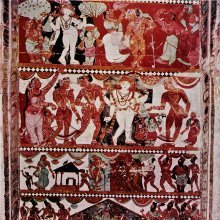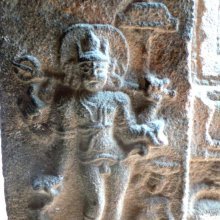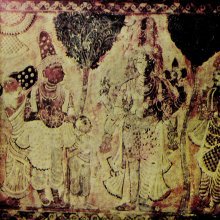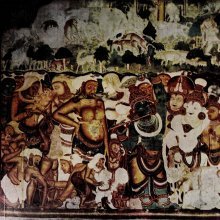Mohini, Mohinī: 25 definitions
Introduction:
Mohini means something in Buddhism, Pali, Hinduism, Sanskrit, the history of ancient India, Marathi, Hindi, biology. If you want to know the exact meaning, history, etymology or English translation of this term then check out the descriptions on this page. Add your comment or reference to a book if you want to contribute to this summary article.
Images (photo gallery)
In Hinduism
Ayurveda (science of life)
Rasashastra (Alchemy and Herbo-Mineral preparations)
Source: Wisdom Library: Rasa-śāstraMohinī (मोहिनी):—One of the sixty-eight Rasauṣadhi, very powerful drugs known to be useful in alchemical processes related to mercury (rasa), according to Rasaprakāśa-sudhākara (chapter 9).
Toxicology (Study and Treatment of poison)
Source: Shodhganga: Kasyapa Samhita—Text on Visha ChikitsaMohinī (मोहिनी) is the name of an ingredient used in the treatment (cikitsā) of bites of spiders (lūtā), according to the Kāśyapa Saṃhitā: an ancient Sanskrit text from the Pāñcarātra tradition dealing with both Tantra and Viṣacikitsā—an important topic from Āyurveda which deals with the study of Toxicology (Viṣavidyā or Sarpavidyā).—In the beginning of the twelfth Adhyāya, Kāśyapasaṃhita adds external and internal antidotes for poisons of various animals and insects. One of the treatments for scorpions (vṛścika) is mentioned as follows: “Scorpion sting can be cured by tying a bandage of Mohinī or Spṛkkā on the place of the sting”.

Āyurveda (आयुर्वेद, ayurveda) is a branch of Indian science dealing with medicine, herbalism, taxology, anatomy, surgery, alchemy and related topics. Traditional practice of Āyurveda in ancient India dates back to at least the first millenium BC. Literature is commonly written in Sanskrit using various poetic metres.
Shaktism (Shakta philosophy)
Source: Wisdom Library: ŚāktismMohinī (मोहिनी, “fascinating woman”):—Name of one of the sixty-four mātṛs to be worshipped during Āvaraṇapūjā (“Worship of the Circuit of Goddesses”, or “Durgā’s Retinue”), according to the Durgāpūjātattva. They should be worshipped with either the five upācāras or perfume and flowers.
Her mantra is as follows:
Source: Kamakoti Mandali: The Yoginis of Narasimha Vyuhaॐ मोहिन्यै नमः
oṃ mohinyai namaḥ.
Mohinī (मोहिनी) is the name of a Mātṛkā-Śakti created by Mahārudra in order to control the plague of demons created by Andhakāsura.—Accordingly, Andhaka-Asura tried to kidnap Umā (Devī Pārvatī), and was fiercely attacked by Mahārudra who shot arrows at him from his mahāpināka. when the arrows pierced the body of Andhakāsura, drops of blood fell to earth and from those drops, thousands of Andhakas arose. To control this plague of demons, Mahārudra created Mātṛkā-Śaktis [viz., Mohinī] and ordered them to drink the blood of the demons and drain them dry.
Source: Kamakoti Mandali: Nrisimha matrika-mandalaMohinī (मोहिनी) refers to one of the various Mātṛkā-Śaktis created by Rudra in order to destroy the clones that spawned from Andhaka’s body.—Accordingly, [...] Andhakāsura attempted to abduct Girājanandinī (Pārvatī) and thus ensued a fierce battle between Andhakāsura and the great Rudra, the Lord of Umā. Like raktabīja, every drop of blood that fell from the body of Andhaka created another Asura like him and in no time, the entire world was filled with Andhakas. To destroy the growing number of Andhakas, Rudra created innumerable Mātṛkā-Śaktis [viz., Mohinī]. These Śaktis of immense power at once began to drink every drop of blood that flowed from the body of Andhaka, but they could still not effectively contain the emergence of more and more demons.

Shakta (शाक्त, śākta) or Shaktism (śāktism) represents a tradition of Hinduism where the Goddess (Devi) is revered and worshipped. Shakta literature includes a range of scriptures, including various Agamas and Tantras, although its roots may be traced back to the Vedas.
Purana and Itihasa (epic history)
Source: archive.org: Puranic EncyclopediaMohinī (मोहिनी).—The female form of Mahāviṣṇu. Devas and Asuras quarrelled with each other over the right of partaking the Amṛta (nectar) obtained from the sea of Milk. At that time Mahāviṣṇu appeared before them in the guise of a beautiful maiden of maddening charm and the asuras were guilefully made to turn their attention on her for some time during which time the nectar was carried away by the Devas. The female form of Mahāviṣṇu was called Mohinī.
Śiva fell in love with Mohinī and by the union of the two was born Śāstā. (See under Amṛtam). (8th Skandha, Bhāgavata).
Source: archive.org: Shiva Purana - English TranslationMohinī (मोहिनी) refers to “deluding someone”, according to the Śivapurāṇa 2.3.4.—Accordingly, as Umā (Durgā/Satī) spoke to the Gods:—“[...] Just as you, Rudra too, desires my incarnation in the abode of Himavat. Hence I shall incarnate. That shall be the end of misery in the world. All of you return to your abodes. You shall be happy for a long time. After incarnating I shall give Menā full happiness. I shall become Śiva’s wife. But this desire is a great secret with me. Śiva’s divine sport is wonderful. It deludes [i.e., mohinī] even the wise. [...]”.
Source: Cologne Digital Sanskrit Dictionaries: The Purana IndexMohinī (मोहिनी).—The thirteenth avatār of Viṣṇu (Nārāyaṇa) to delude the Asuras from having any share of the amṛta and distribute it to the Devas; reappeared in that form before Śiva at his request and Śiva who got enamoured of her, ran after her letting his seed fall down;1 a Śakti.2
- 1) Bhāgavata-purāṇa I. 3. 17; VIII. 8. 41-46; Chh. 9 and 12 (whole) Matsya-purāṇa 251. 7; Vāyu-purāṇa 25. 48.
- 2) Brahmāṇḍa-purāṇa IV. 10. 27. 34; 19. 65 and 74; 20. 6, 38 and 57; 44. 72 and 141.

The Purana (पुराण, purāṇas) refers to Sanskrit literature preserving ancient India’s vast cultural history, including historical legends, religious ceremonies, various arts and sciences. The eighteen mahapuranas total over 400,000 shlokas (metrical couplets) and date to at least several centuries BCE.
Natyashastra (theatrics and dramaturgy)
Source: Wisdom Library: SaṅgītaśiromaṇiMohinī (मोहिनी) refers to “the bewildering one” and is the presiding deity of śobhī (‘brilliant’), according to the Saṅgītaśiromaṇi 67-84. Śobhī represents one of the sixteen words that together make up the elā musical composition (prabandha). Elā is an important subgenre of song and was regarded as an auspicious and important prabandha (composition) in ancient Indian music (gāndharva). According to nirukta analysis, the etymological meaning of elā can be explained as follows: a represents Viṣṇu, i represents Kāmadeva, la represents Lakṣmī.
Mohinī is one of the sixteen deities presiding over the corresponding sixteen words of the elā-prabandha, all of which are defined in the Saṅgītaśiromaṇi (“crest-jewel of music”): a 15th-century Sanskrit work on Indian musicology (gāndharvaśāstra).

Natyashastra (नाट्यशास्त्र, nāṭyaśāstra) refers to both the ancient Indian tradition (shastra) of performing arts, (natya—theatrics, drama, dance, music), as well as the name of a Sanskrit work dealing with these subjects. It also teaches the rules for composing Dramatic plays (nataka), construction and performance of Theater, and Poetic works (kavya).
Vaishnavism (Vaishava dharma)
Source: Devotees Vaishnavas: Śrī Garga SaṃhitāMohinī (मोहिनी) refers to the twelfth of twenty-six ekādaśīs according to the Garga-saṃhitā 4.8.9. Accordingly, “to attain Lord Kṛṣṇa’s mercy you should follow the vow of fasting on ekādaśī. In that way You will make Lord Kṛṣṇa into your submissive servant. Of this there is no doubt”. A person who chants the names of these twenty-six ekādaśīs (e.g., Mohinī) attains the result of following ekādaśī for one year.

Vaishnava (वैष्णव, vaiṣṇava) or vaishnavism (vaiṣṇavism) represents a tradition of Hinduism worshipping Vishnu as the supreme Lord. Similar to the Shaktism and Shaivism traditions, Vaishnavism also developed as an individual movement, famous for its exposition of the dashavatara (‘ten avatars of Vishnu’).
Chandas (prosody, study of Sanskrit metres)
Source: Journal of the University of Bombay Volume II: Apabhramsa metres (1)Mohinī (मोहिनी) refers to a variety of Raḍḍā or Mātrā: the only metre consisting of five lines, as discussed in books such as the Chandonuśāsana, Kavidarpaṇa, Vṛttajātisamuccaya and Svayambhūchandas.—Mātrā seems to be a very old Apabhraṃśa metre since it was known to Virahāṅka (see Vṛttajātisamuccaya). Piṅgala discusses [the Mātrā metre] under Raḍḍā, and gives seven varieties of it [viz., Mohinī, consisting of the following mātrās: 19.11,19,11.19].

Chandas (छन्दस्) refers to Sanskrit prosody and represents one of the six Vedangas (auxiliary disciplines belonging to the study of the Vedas). The science of prosody (chandas-shastra) focusses on the study of the poetic meters such as the commonly known twenty-six metres mentioned by Pingalas.
General definition (in Hinduism)
Source: Shodhganga: Historical setting of the vaisnava divyaksetras in the southern pandya countryMohinī (मोहिनी) is one among the aṃśāvatāras of the Lord [Viṣṇu]. The Mohinī incarnation takes place a fter the Churning of the Ocean of Milk. The ocean was churned by the gods and demons for possession of the nectar.
Source: Shodhganga: Historical setting of the vaisnava divyaksetras in the southern pandya countryMohinī (मोहिनी) is one among the aṃśāvataras of Viṣṇu. Viṣṇu is said to have appeared as Mohinī on the following occasions:
- To distribute the amṛta among the gods and demons,
- Followed Bhikṣāṭana to the Dārukavana,
- Mohinī with Bhasmāsura,
- Mohinī and Śiva dallying and the birth of Hariharaputra.
In Buddhism
Tibetan Buddhism (Vajrayana or tantric Buddhism)
Source: OSU Press: Cakrasamvara SamadhiMohinī (मोहिनी) is the name of a deity [i.e., oṃ hrīṃ moṃ mohinyai svāhā], according to the Guru Mandala Worship (maṇḍalārcana) ritual often performed in combination with the Cakrasaṃvara Samādhi, which refers to the primary pūjā and sādhanā practice of Newah Mahāyāna-Vajrayāna Buddhists in Nepal.—

Tibetan Buddhism includes schools such as Nyingma, Kadampa, Kagyu and Gelug. Their primary canon of literature is divided in two broad categories: The Kangyur, which consists of Buddha’s words, and the Tengyur, which includes commentaries from various sources. Esotericism and tantra techniques (vajrayāna) are collected indepently.
India history and geography
Source: Cologne Digital Sanskrit Dictionaries: Indian Epigraphical GlossaryMohinī.—(IA 19), female devils who possess men. Note: mohinī is defined in the “Indian epigraphical glossary” as it can be found on ancient inscriptions commonly written in Sanskrit, Prakrit or Dravidian languages.

The history of India traces the identification of countries, villages, towns and other regions of India, as well as mythology, zoology, royal dynasties, rulers, tribes, local festivities and traditions and regional languages. Ancient India enjoyed religious freedom and encourages the path of Dharma, a concept common to Buddhism, Hinduism, and Jainism.
Biology (plants and animals)
Source: Google Books: CRC World Dictionary (Regional names)1) Mohini in India is the name of a plant defined with Desmodium heterocarpon in various botanical sources. This page contains potential references in Ayurveda, modern medicine, and other folk traditions or local practices It has the synonym Hedysarum canum J.F. Gmel., nom. superfl . (among others).
2) Mohini in Nepal is also identified with Ageratina adenophora.
3) Mohini is also identified with Caryopteris foetida It has the synonym Clerodendrum foetidum Bunge (etc.).
Example references for further research on medicinal uses or toxicity (see latin names for full list):
· Revisio Generum Plantarum (1891)
· Enum. Pl. Chin. Bor. (1833)
· Natural history (1897)
· Transactions of the Linnean Society of , London. (1931)
· Systema Vegetabilium (1826)
· Prodromus Systematis Naturalis Regni Vegetabilis (1847)
If you are looking for specific details regarding Mohini, for example health benefits, pregnancy safety, extract dosage, side effects, diet and recipes, chemical composition, have a look at these references.

This sections includes definitions from the five kingdoms of living things: Animals, Plants, Fungi, Protists and Monera. It will include both the official binomial nomenclature (scientific names usually in Latin) as well as regional spellings and variants.
Languages of India and abroad
Marathi-English dictionary
Source: DDSA: The Molesworth Marathi and English Dictionarymōhinī (मोहिनी).—f S Bewitching, besotting, fascinating, depriving of sense or understanding.
Source: DDSA: The Aryabhusan school dictionary, Marathi-Englishmōhinī (मोहिनी).—f Bewitching, besotting.
Marathi is an Indo-European language having over 70 million native speakers people in (predominantly) Maharashtra India. Marathi, like many other Indo-Aryan languages, evolved from early forms of Prakrit, which itself is a subset of Sanskrit, one of the most ancient languages of the world.
Sanskrit dictionary
Source: DDSA: The practical Sanskrit-English dictionaryMohinī (मोहिनी).—
1) Name of an Apsaras.
2) A fascinating woman (the form assumed by Viṣṇu at the time of cheating the demons of nectar.)
3) The flower of a kind of jasmine.
Source: Cologne Digital Sanskrit Dictionaries: Shabda-Sagara Sanskrit-English DictionaryMohinī (मोहिनी).—f. (-nī) 1. A kind of jasmine, commonly Tripuramali. 2. Vishnu in the form of a fascinating woman. 3. A name of an Apsara. E. moha folly, ini aff., and fem. aff. ṅīṣ .
Source: Cologne Digital Sanskrit Dictionaries: Monier-Williams Sanskrit-English Dictionary1) Mohinī (मोहिनी):—[from mohin > moha] f. a fascinating woman, [Monier-Williams’ Sanskrit-English Dictionary] (cf. [Religious Thought and Life in India 65 n. 1])
2) [v.s. ...] the flower of a species of jasmine, [cf. Lexicographers, esp. such as amarasiṃha, halāyudha, hemacandra, etc.]
3) [v.s. ...] Name of an Apsaras, [Pañcarātra]
4) [v.s. ...] of a daughter of Rukmāṅgada, [Viṣṇu-purāṇa]
Source: DDSA: Paia-sadda-mahannavo; a comprehensive Prakrit Hindi dictionary (S)Mohinī (मोहिनी) in the Sanskrit language is related to the Prakrit word: Mohaṇī.
Sanskrit, also spelled संस्कृतम् (saṃskṛtam), is an ancient language of India commonly seen as the grandmother of the Indo-European language family (even English!). Closely allied with Prakrit and Pali, Sanskrit is more exhaustive in both grammar and terms and has the most extensive collection of literature in the world, greatly surpassing its sister-languages Greek and Latin.
Hindi dictionary
Source: DDSA: A practical Hindi-English dictionaryMohinī (मोहिनी):—(a) who tempts/charms / attracts / casts a spell (feminine adjectival form); (nf) see [mohinī].
...
Kannada-English dictionary
Source: Alar: Kannada-English corpusMōhini (ಮೋಹಿನಿ):—
1) [noun] a beautiful woman; a charming lady.
2) [noun] (myth.) name of a celestial woman.
3) [noun] the seductive female form that Viṣṇu took while sharing between the gods and demons the ambrosia got from churning the ocean.
4) [noun] a female ghost (said to be of young women died an unnatural death) in the form of a beautiful woman, believed to seduce men.
5) [noun] a woman who lures, seduces men.
6) [noun] a kind of black magic, sorcery.
7) [noun] a kind of mystical power used to make a person lose consciousness.
8) [noun] a kind of plant.
Kannada is a Dravidian language (as opposed to the Indo-European language family) mainly spoken in the southwestern region of India.
Nepali dictionary
Source: unoes: Nepali-English DictionaryMohinī (मोहिनी):—adj. fem. charming; enchanting; appealing; n. 1. Mythol. name of an Apsara; 2. Mythol. Vishnu as an alluring woman who duped the demons with her beauty and gave the nectar of immortality to the gods; 3. a species of Jasmine; 4. hypnotism; enchantment;
Nepali is the primary language of the Nepalese people counting almost 20 million native speakers. The country of Nepal is situated in the Himalaya mountain range to the north of India.
See also (Relevant definitions)
Starts with: Mohini gida, Mohini mantra, Mohini vaishakhashukla, Mohiniattam, Mohinimantra, Mohinimurti, Mohinirajasahasranamavali, Mohinirupa, Mohinishkasana, Mohiniyattam.
Ends with (+3): Akhilamohini, Alimohini, Balamohini, Bhuvanamohini, Gandhamohini, Jaganmohinī, Janamohini, Madanamohini, Manamohini, Manomohini, Mayavimohini, Naramohini, Pramohini, Sammohini, Sarvamohini, Sarvasammohini, Sumohini, Suramohini, Trailokyamohini, Trijagamohini.
Full-text (+53): Gandhamohini, Mohani, Mohini gida, Mahavyahriti, Gandhamodini, Cekanmokini, Mohinimantra, Mohinirajasahasranamavali, Alimohini, Mohini vaishakhashukla, Naramohini, Mohini mantra, Suramohini, Manomohini, Shasta, Trijagamohini, Iyappa, Jaganmohinī, Janamohini, Kandukalila.
Relevant text
Search found 42 books and stories containing Mohini, Mohinī, Mōhinī, Mōhini; (plurals include: Mohinis, Mohinīs, Mōhinīs, Mōhinis). You can also click to the full overview containing English textual excerpts. Below are direct links for the most relevant articles:
Garga Samhita (English) (by Danavir Goswami)
Verses 2.20.31-32 < [Chapter 20 - The Rāsa-dance Pastime]
Verse 4.8.8 < [Chapter 8 - In the Story of the Yajña-sītās, the Glories of Ekādaśī]
Verse 5.15.29 < [Chapter 15 - Seeing Sri Radha]
Shrimad Bhagavad-gita (by Narayana Gosvami)
Verse 9.12 < [Chapter 9 - Rāja-guhya-yoga (Yoga through the most Confidential Knowledge)]
Verse 18.55 < [Chapter 18 - Mokṣa-yoga (the Yoga of Liberation)]
Hari-bhakti-kalpa-latikā (by Sarasvati Thkura)
Text 2 < [Second Stabaka]
Brihad Bhagavatamrita (commentary) (by Śrī Śrīmad Bhaktivedānta Nārāyana Gosvāmī Mahārāja)
Verse 2.3.25 < [Chapter 3 - Bhajana (loving service)]
Verse 1.4.95-96 < [Chapter 4 - Bhakta (the devotee)]
Verse 2.3.35 < [Chapter 3 - Bhajana (loving service)]
The Picture of Modern Indian Woman in “Music < [January – March, 2007]
Keralee-Nritham or Mohini Attam < [November-December 1934]
Dr. Bhabani Bhattacharya as a Novelist < [April 1971]
Sahitya-kaumudi by Baladeva Vidyabhushana (by Gaurapada Dāsa)
Text 11.18 < [Chapter 11 - Additional Ornaments]
Text 6.4 < [Chapter 6 - Third-rate Poetry and Super-excellent Poetry]
Related products






